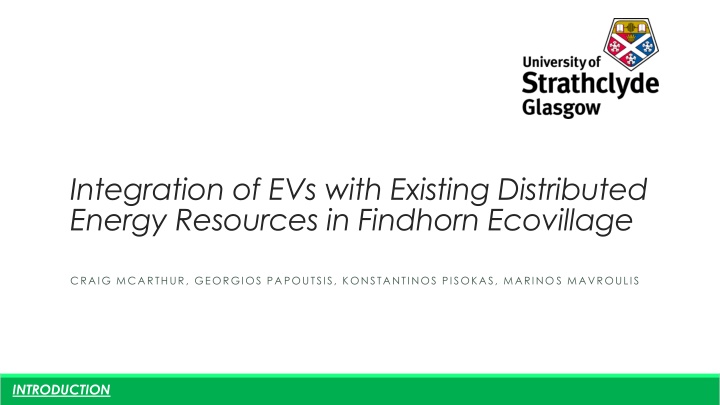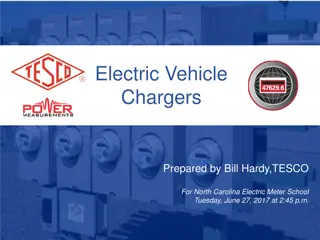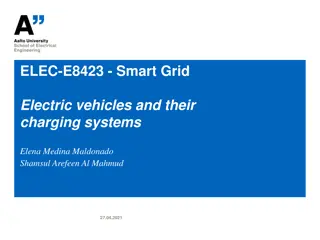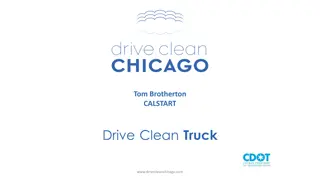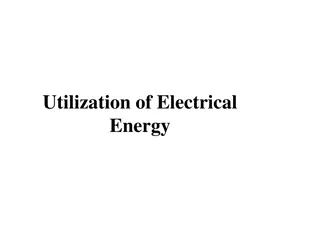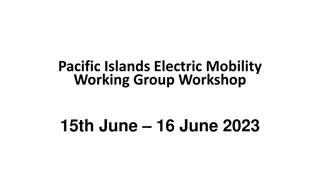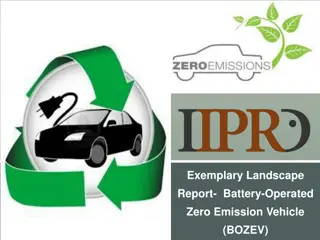Integration of Electric Vehicles with Existing Distributed Energy Resources at Findhorn Ecovillage
This project focuses on studying the impact of electric vehicle adoption on electricity demand/generation at Findhorn Ecovillage. The aim is to create models for EV battery output, simulate new demand scenarios, and evaluate the potential impact on remaining a net exporter of electricity, considering the growing interest in EVs and existing distributed energy resources at the ecovillage.
Download Presentation

Please find below an Image/Link to download the presentation.
The content on the website is provided AS IS for your information and personal use only. It may not be sold, licensed, or shared on other websites without obtaining consent from the author.If you encounter any issues during the download, it is possible that the publisher has removed the file from their server.
You are allowed to download the files provided on this website for personal or commercial use, subject to the condition that they are used lawfully. All files are the property of their respective owners.
The content on the website is provided AS IS for your information and personal use only. It may not be sold, licensed, or shared on other websites without obtaining consent from the author.
E N D
Presentation Transcript
Integration of EVs with Existing Distributed Energy Resources in Findhorn Ecovillage CRAIG MCARTHUR, GEORGIOS PAPOUTSIS, KONSTANTINOS PISOKAS, MARINO S MAVROULIS INTRODUCTION
Project Aim To study the effect of EV adoption on the electricity demand/generation in Findhorn Ecovillage Objectives Create a EV battery model to output time-series charging demand Create a model to generate an annual time-series EV charging demand for Findhorn in Ecovillage Model 25%, 50%, 75%, 100% EV Adoption Simulate the new Ecovillage demand and assess the impact according to the Key Performance Indicator o Remain a net exporter of electricity INTRODUCTION
Why? Energy Consumption UK 2016 Transport accounts for 40% of energy consumption 1 in 50 new cars sold is an electric vehicle Implications for the grid Is decentralization the future? INTRODUCTION
Findhorn Ecovillage Distributed Energy Resources oWind: 3 V29 (225kW), 1 V17 (75kW) oSolar PV (25kW) oRedox Flow Battery (Inactive) Ecovillage of 500 residents Emerging interest in EVs Long-term affect for Ecovillage? INTRODUCTION
Objectives Create a EV battery model to output time-series charging demand Create a model to generate an annual time-series EV charging demand for Findhorn in Ecovillage Simulate the new Ecovillage demand and assess the impact according to determined Key Performance Indicators o Remain a net exporter of electricity INTRODUCTION
Model Methodology CONSTRUCTING THE MODEL
Selecting EVs BMW i3 Nissan Leaf Renault Zoe CONSTRUCTING THE MODEL
Simulink EV Battery Model Nominal Voltage Simulink Battery Model Time-series power demand Rated Capacity Charging Simulator EV Type Customisable Parameters CONSTRUCTING THE MODEL
Battery Charging Results Nissan Leaf CONSTRUCTING THE MODEL
Model Methodology CONSTRUCTING THE MODEL
Findhorn Census Data Method of Travel to Work Distance Travelled to Work Weekly Working Hours CONSTRUCTING THE MODEL
Model Methodology CONSTRUCTING THE MODEL
Demand Profile Calculator Simulink Results EV Type 30 min Winter Demand Weekly Work Travel Profile Profile Weekly Home Travel Carbon Emission Hours Worked Report 3-Week Simulation Calculator 30min Summer Demand Average Weekly Distance Travelled km Deficit *Charging Behaviour * My Electric Avenue EV Study * Findhorn Ecovillage Carbon Assessment 2015 CONSTRUCTING THE MODEL
Controlled vs Uncontrolled 100% EV Adoption MODEL OUTPUTS
The Effect on Findhorn Ecovillage Remain a net exporter of electricity? Would storage assist? Do Findhorn Ecovillage require additional generation? MODEL OUTPUTS
Model Methodology HOMERPRO RESULTS
Total Electricity Implications HOMERPRO RESULTS
Investigating Further Reduced surplus electricity to sell back to grid Notable increase in dependence on grid HOMERPRO RESULTS
Redox Flow Battery 25 kW, 50 kWh Imports Increase (%) Surplus Decrease (%) Scenario Without Battery Redox Battery Without Battery Redox Battery 25% EVs 12.5% 8.5% -4.9% -9.0% 50% EVs 23.8% 19.8% -9.0% -12.9% 75% EVs 35.3% 31.5% -13.6% -17.3% 100% EVs 47.0% 43.6% -17.9% -22.6% HOMERPRO RESULTS
Redox Flow Battery 25 kW, 50 kWh HOMERPRO RESULTS
Integrating New Wind Generation HOMERPRO RESULTS
Is Solar PV More Suitable? HOMERPRO RESULTS
Net Exporter of Electricity? SUGGESTIONS
Considering the Surplus SUGGESTIONS
Final Proposal Implement controlled charging Existing EV control Utilise the Redox Flow Battery Install 300 kW solar PV farm Surrounding area owned suitable SUGGESTIONS
Conclusion Ecovillage will be net importer at 50% EV adoption Mitigation required to remain net exporter Current generation is wind-dependant Requires complimentary generation during summer 300 kW solar PV installation achieves 43% grid imports at 100% EV adoption Increases surplus, decreases grid imports CONCLUSION
Future Work Simulate further control situations and different charger types Investigate vehicle-to-grid connection Mitigate need for scaled storage Financial analysis of surplus/import implications Analyse carbon footprint consequences of adoption Larger renewable capacity installation to reduce CO2 emissions CONCLUSION
Questions? CONCLUSION
